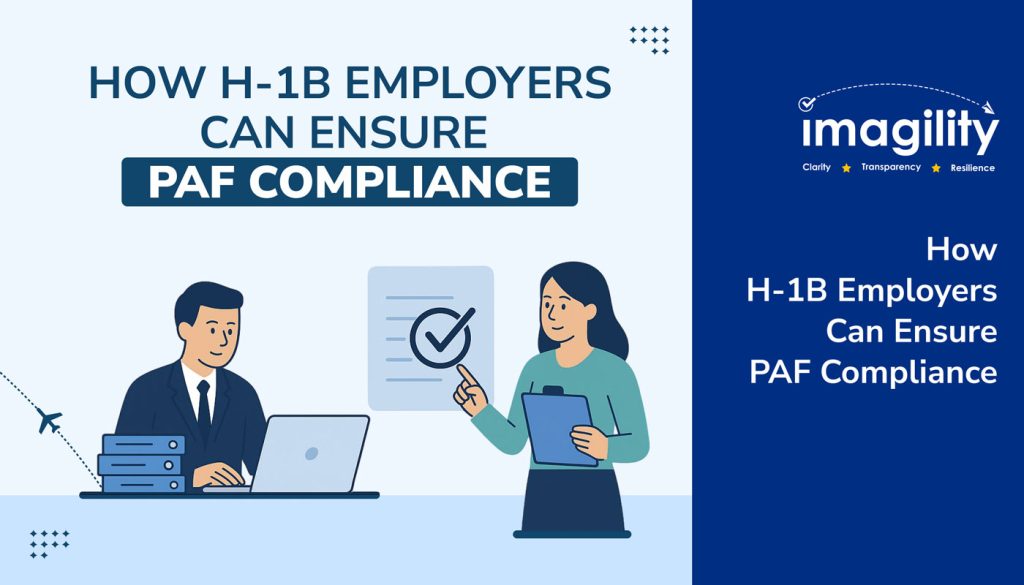Hiring global talent through the H-1B program brings great opportunities, but it also comes with important compliance responsibilities. One of the most critical requirements is maintaining a Public Access File (PAF). The PAF ensures transparency in how H-1B workers are paid and treated, and mistakes in managing it can lead to costly fines, audits, or even loss of H-1B privileges.
In this blog, we break down what employers need to know about PAFs, common errors to avoid, and best practices for staying compliant.
What is a Public Access File?
A Public Access File (PAF) is a set of documents that H-1B employers are legally required to maintain under Department of Labor (DOL) regulations. The purpose of the PAF is transparency. It allows the public, including current employees, prospective hires, or even competitors, to review certain information about how an employer is compensating and treating H-1B workers.
Unlike other internal records, the PAF must be available for public inspection within one working day of filing a Labor Condition Application (LCA).
Why is Maintaining a PAF Important?
Maintaining a compliant PAF is a regulatory obligation. A properly organized PAF demonstrates that your organization:
- Is paying H-1B employees the required wage.
- Is not adversely affecting the working conditions of U.S. workers.
- Is operating in good faith within immigration and labor laws.
Failure to maintain or produce an accurate PAF can result in investigations, fines, reputational damage, and potential debarment from the H-1B program.
What Documents are Included in a PAF?
The Department of Labor requires the following key documents to be included in every H-1B Public Access File:
- A copy of the certified Labor Condition Application (LCA).
- Documentation of the wage rate for the H-1B employee.
- An explanation of the actual wage system used by the employer.
- A summary of the benefits offered to U.S. and H-1B employees.
- Proof that the employee is being paid at least the required wage (such as prevailing wage documentation).
- Evidence of notice to U.S. workers (e.g., posting notices at the worksite or electronic notification).
Common PAF Errors Employers Make
Below is the list of common PAF errors that employers make while preparing the file. These include:
- Missing or incomplete documentation: Employers often fail to include a prevailing wage determination or a clear wage explanation.
- Outdated or inaccurate information: Wage updates, role changes, or new benefits must be reflected in the PAF but are often overlooked.
- Failure to make files available on time: The PAF must be accessible within one day of filing the LCA.
- Mixing PAFs with confidential employee records: A PAF is a public file and should not contain private information such as Social Security numbers, I-129 forms, or payroll records.
- Improper file retention: Employers sometimes discard PAFs too early. Files must be retained for at least one year beyond the last date of H-1B employment.
Consequences of PAF Non-Compliance
The Department of Labor takes PAF compliance seriously. Non-compliance can trigger investigations, penalties, and corrective actions. Potential consequences include:
- Hefty fines up to $55,570 per violation.
- Orders to provide back wages if underpayment is discovered.
- Negative publicity if violations become public.
- In severe cases, debarment from the H-1B program for one to three years.
For employers relying on specialized foreign workers, such penalties can disrupt business operations, harm long-term growth, and damage the reputation.
How Can H-1B Employers Maintain PAF Compliance?
Employers can stay compliant by following these best practices:
- Use a checklist: Establish a clear checklist for every H-1B hire to ensure all required documents are included in the PAF.
- Train HR and compliance teams: Make sure HR and compliance staff know what belongs in the PAF and what should stay in private employee files.
- Retain records for the required period: When an H-1B employee leaves the organization, the employer is supposed to retain the PAF one year beyond the last date of employment under the LCA or for the duration of the LCA, whichever is longer.
- Leverage technology: Immigration Software like Imagility helps employers stay compliant by automating LCA and PAF creation, tracking deadlines, and preventing errors. It ensures that all required documents are in place and ready for inspection.
- Conduct regular audits: Periodic internal reviews help identify and correct gaps before they escalate into compliance issues.
- Consult your attorney: Keep your attorney updated and consult in case there is any doubt.
- Stay updated on regulatory changes: U.S. Citizenship and Immigration Services (USCIS) may change the H-1B and LCA policies to enhance the transparency and accountability of the immigration process. Employers must stay updated to adjust the processes accordingly.
Final Thoughts
Managing a PAF may seem overwhelming, but it is one of the most critical parts of H-1B compliance. By avoiding common errors and using tools like Imagility, employers can stay LCA compliant, protect themselves from costly penalties, and build a strong reputation as a responsible H-1B sponsor. To make the process even easier, download our free Public Access Files Playbook for a simple step-by-step guide to PAF management.










